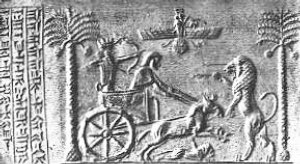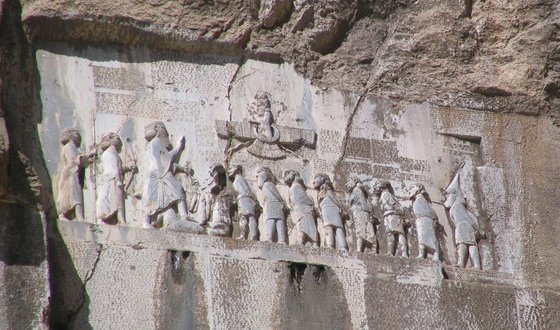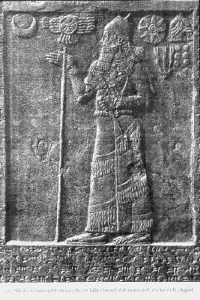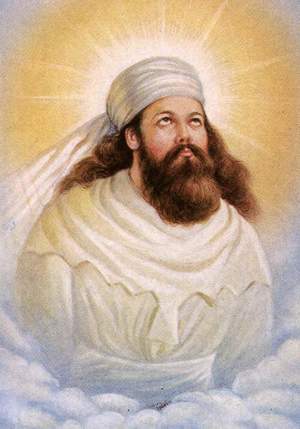|
Persia - Assyria Winged Flying Craft or Angels? |
|||||||||
The Faravahar (Avestan), Farohar (middle Persian), Foroohar or Forouhar is one of the best known symbols of the Zoroastrian religion. What the figure symbolizes is disputed. While it is currently thought to represent a Fravashi (c. an individual's guardian angel), what it represented in the minds of those who adapted it from earlier Mesopotamian and Egyptian reliefs is unclear. Historically, the symbol is influenced by the "winged sun" hieroglyph appearing on Bronze Age royal seals (Luwian SOL SUUS, symbolizing royal power in particular). In Zoroastrian angelology, a fravashi (Farvadin) is a Yazata, responsible to the archangel Haurvatat (Khordad Amesha Spenta), whose special domain is water. The principal source of
information on the fravarshi is Yasht 13,
where they appear as beings who inhabit the stratosphere,
and aid and protect those who worship them. In the
Farvardin Yasht, the
farvarshi are described as a vast
host of "many hundreds,
many thousands, many tens of thousands"
aiding Ahura Mazda in the
creation
of the universe.
Webmaster's Note: This is a very important
fact as it relates to the Anunnaki
|
|||||||||
| Darius The
Great
Darius I, Darrioush in Persian, also
known as Darayarahush
Source
for
More Reading - Iran Chamber Society
|
|||||||||
Zoroaster, in a popular Parsi Zoroastrian depiction. This personified image of Zoroaster emerged in the 18th century, the result of an Indian Parsi Zoroastrian artist's imaginings; it quickly became a popular icon, and is now regarded by many Zoroastrians as being historically based. Zoroaster, in a popular Parsi Zoroastrian depiction. This personified image of Zoroaster emerged in the 18th century, the result of an Indian Parsi Zoroastrian artist's imaginings; it quickly became a popular icon, and is now regarded by many Zoroastrians as being historically based. Zarathushtra (Avestan: ZaratŘuštra), usually known in English as Zoroaster (after the Greek version) was an ancient Iranian prophet, and the founder of Zoroastrianism, which was the national religion of the Sassanian Empire of Persia, and played an important role in the earlier Achaemenean and Parthian regimes. In Persian, the name takes the form Zartosht. Zoroaster is generally accepted as a historical figure, but efforts to date Zoroaster vary widely. Scholarly estimates are usually roughly near 1200 BC, making him a candidate as the founder of the earliest religion based on revealed scripture, while others place him anywhere between the 18th and the 6th centuries BC. Mythological Zoroaster was famous in classical antiquity as the founder of the religion of the Magi. His name is cited by Xanthus, and in the Alcibiades of Plato as well as by Plutarch, Pliny the Elder and Diogenes Laertius. Ancient Greek estimates are dependent upon Persian mythology, and give dates as early as the 7th millennium BC. These are the dates to which Parsis subscribe. Persian mythology, mainly the Shahnama of Ferdowsi, and oral tradition place Zoroaster quite early. Manly Palmer Hall in his book, Twelve World Teachers, arrives at a rough estimate ranging from 10000 BCE to 1000 BCE. Other
Reading:
|
|||||||||
| Histories
of Herodotus
A history source of Persian Empire of Achaemenian era By: Herodotus (c. 484 - 425 BCE); Translated by: George Rawlinson |
|||||||||
| FAIR USE NOTICE: This page contains copyrighted material the use of which has not been specifically authorized by the copyright owner. Pegasus Research Consortium distributes this material without profit to those who have expressed a prior interest in receiving the included information for research and educational purposes. We believe this constitutes a fair use of any such copyrighted material as provided for in 17 U.S.C § 107. If you wish to use copyrighted material from this site for purposes of your own that go beyond fair use, you must obtain permission from the copyright owner. | |||||||||
|
|








